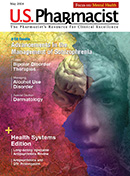The interim evaluation was of the 2023 Southern Hemisphere influenza vaccine formulation, which is similar to that now being administered in the Northern Hemisphere, was conducted using data from five countries.
The article in the CDC’s Morbidity & Mortality Weekly Report advised that the effectiveness of seasonal influenza vaccine varies by season and circulating virus type.
The authors report that the 2023 Southern Hemisphere seasonal influenza vaccine reduced the risk for influenza-associated hospitalizations by 52%. “Circulating influenza viruses were genetically similar to those targeted by the 2023–24 Northern Hemisphere influenza vaccine formulation,” according to the article. “This vaccine might offer similar protection if these viruses predominate during the coming Northern Hemisphere influenza season.”
“Evaluations of vaccine effectiveness during the March–September Southern Hemisphere influenza season can provide valuable information for countries currently experiencing the influenza season and preceding the October–May Northern Hemisphere influenza season,” the researchers pointed out. “Since 2013, multiple countries have participated in the Network for the Evaluation of Vaccine Effectiveness in Latin America and the Caribbean to estimate and monitor vaccine effectiveness [VE] in preventing severe acute respiratory infection (SARI)–associated hospitalization.”
The results were based on data contributed by Argentina, Brazil, Chile, Paraguay, and Uruguay on 2,780 SARI patients hospitalized from March 27, 2023, to July 9, 2023. The adjusted VE against SARI hospitalization associated with any influenza virus during the 2023 Southern Hemisphere season was 51.9% (95% CI, 39.2%-62.0%), including 55.2% (95% CI, 41.8%-65.5%) against the predominating A(H1N1)pdm09.
“These early, interim estimates, provided before the expected end of seasonal influenza virus circulation, suggest that vaccination substantially reduced the risk for severe influenza illnesses, underscoring the benefits of influenza vaccination,” according to the report. “In anticipation of Northern Hemisphere influenza virus circulation, the World Health Organization and CDC recommend that health authorities encourage healthcare providers to administer annual influenza vaccination to all eligible persons, particularly emphasizing the importance of vaccination for persons at increased risk for severe outcomes (e.g., very young children, persons with preexisting health conditions [including pregnant women], and older adults).”
The researchers cautioned that the “timing and intensity of influenza epidemics in one hemisphere are not necessarily predictive of subsequent epidemics in the opposite hemisphere, this report might help health officials in Northern Hemisphere jurisdictions prepare for a potentially early influenza season and highlight the benefits of vaccination.”
The researchers noted that, in mid-September, most influenza detections in the United States had identified A(H1N1)pdm09 and B/Victoria viruses, which was a similar pattern to that identified among the evaluated Southern Hemisphere countries. “Nevertheless, whether influenza A(H1N1)pdm09 will remain the predominant virus in the United States during the October 2023–May 2024 Northern Hemisphere influenza season is unclear,” the authors added.
The content contained in this article is for informational purposes only. The content is not intended to be a substitute for professional advice. Reliance on any information provided in this article is solely at your own risk.






